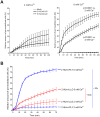Missing elimination via membrane vesicle shedding contributes to the diminished calcium sensitivity of listeriolysin O
- PMID: 30367146
- PMCID: PMC6203718
- DOI: 10.1038/s41598-018-34031-4
Missing elimination via membrane vesicle shedding contributes to the diminished calcium sensitivity of listeriolysin O
Abstract
The lytic capacity of cholesterol-dependent cytolysins is enhanced in the extracellular calcium-free environment through a combination of limited membrane repair and diminished membrane toxin removal. For a typical neurotoxin of the group, pneumolysin, this effect has already been observed at reduced (1 mM) calcium conditions, which are pathophysiologically relevant. Here, we tested another neurotoxin of the group, listeriolysin O from L. monocytogenes, active in the primary vacuole after bacterium phagocytosis in host cells. Reduced calcium did not increase the lytic capacity of listeriolysin (in contrast to pneumolysin), while calcium-free conditions elevated it 2.5 times compared to 10 times for pneumolysin (at equivalent hemolytic capacities). To clarify these differences, we analyzed membrane vesicle shedding, known to be a calcium-dependent process for toxin removal from eukaryotic cell membranes. Both pneumolysin and listeriolysin initiated vesicle shedding, which was completely blocked by the lack of extracellular calcium. Lack of calcium, however, elevated the toxin load per a cell only for pneumolysin and not for listeriolysin. This result indicates that vesicle shedding does not play a role in the membrane removal of listeriolysin and outlines a major difference between it and other members of the CDC group. Furthermore, it provides new tools for studying membrane vesicle shedding.
Conflict of interest statement
The authors declare no competing interests.
Figures




Similar articles
-
Distinct Neurotoxicity Profile of Listeriolysin O from Listeria monocytogenes.Toxins (Basel). 2017 Jan 13;9(1):34. doi: 10.3390/toxins9010034. Toxins (Basel). 2017. PMID: 28098781 Free PMC article.
-
Down-regulation of acid sphingomyelinase and neutral sphingomyelinase-2 inversely determines the cellular resistance to plasmalemmal injury by pore-forming toxins.FASEB J. 2019 Jan;33(1):275-285. doi: 10.1096/fj.201800033R. Epub 2018 Jul 6. FASEB J. 2019. PMID: 29979630
-
Intrinsic repair protects cells from pore-forming toxins by microvesicle shedding.Cell Death Differ. 2017 May;24(5):798-808. doi: 10.1038/cdd.2017.11. Epub 2017 Feb 10. Cell Death Differ. 2017. PMID: 28186501 Free PMC article.
-
Lipid rafts clustering and signalling by listeriolysin O.Biochem Soc Trans. 2004 Nov;32(Pt 5):712-4. doi: 10.1042/BST0320712. Biochem Soc Trans. 2004. PMID: 15493995 Review.
-
Listeriolysin O: a phagosome-specific lysin.Microbes Infect. 2007 Aug;9(10):1176-87. doi: 10.1016/j.micinf.2007.05.005. Epub 2007 May 7. Microbes Infect. 2007. PMID: 17720603 Review.
Cited by
-
Interaction of Macrophages and Cholesterol-Dependent Cytolysins: The Impact on Immune Response and Cellular Survival.Toxins (Basel). 2020 Aug 19;12(9):531. doi: 10.3390/toxins12090531. Toxins (Basel). 2020. PMID: 32825096 Free PMC article. Review.
-
Membrane Binding, Cellular Cholesterol Content and Resealing Capacity Contribute to Epithelial Cell Damage Induced by Suilysin of Streptococcus suis.Pathogens. 2019 Dec 30;9(1):33. doi: 10.3390/pathogens9010033. Pathogens. 2019. PMID: 31905867 Free PMC article.
-
Phobalysin: Fisheye View of Membrane Perforation, Repair, Chemotaxis and Adhesion.Toxins (Basel). 2019 Jul 16;11(7):412. doi: 10.3390/toxins11070412. Toxins (Basel). 2019. PMID: 31315179 Free PMC article. Review.
-
The Yin and Yang of Pneumolysin During Pneumococcal Infection.Front Immunol. 2022 Apr 22;13:878244. doi: 10.3389/fimmu.2022.878244. eCollection 2022. Front Immunol. 2022. PMID: 35529870 Free PMC article. Review.
-
Pneumolysin boosts the neuroinflammatory response to Streptococcus pneumoniae through enhanced endocytosis.Nat Commun. 2022 Aug 26;13(1):5032. doi: 10.1038/s41467-022-32624-2. Nat Commun. 2022. PMID: 36028511 Free PMC article.
References
MeSH terms
Substances
Grants and funding
- SFB-TR 84/Deutsche Forschungsgemeinschaft (German Research Foundation)/International
- SFB-TR 84/Deutsche Forschungsgemeinschaft (German Research Foundation)/International
- IL 151.1-1/Deutsche Forschungsgemeinschaft (German Research Foundation)/International
- WT094762MA/WT_/Wellcome Trust/United Kingdom
- 31003A_160136/1/Schweizerischer Nationalfonds zur Förderung der Wissenschaftlichen Forschung (Swiss National Science Foundation)/International

